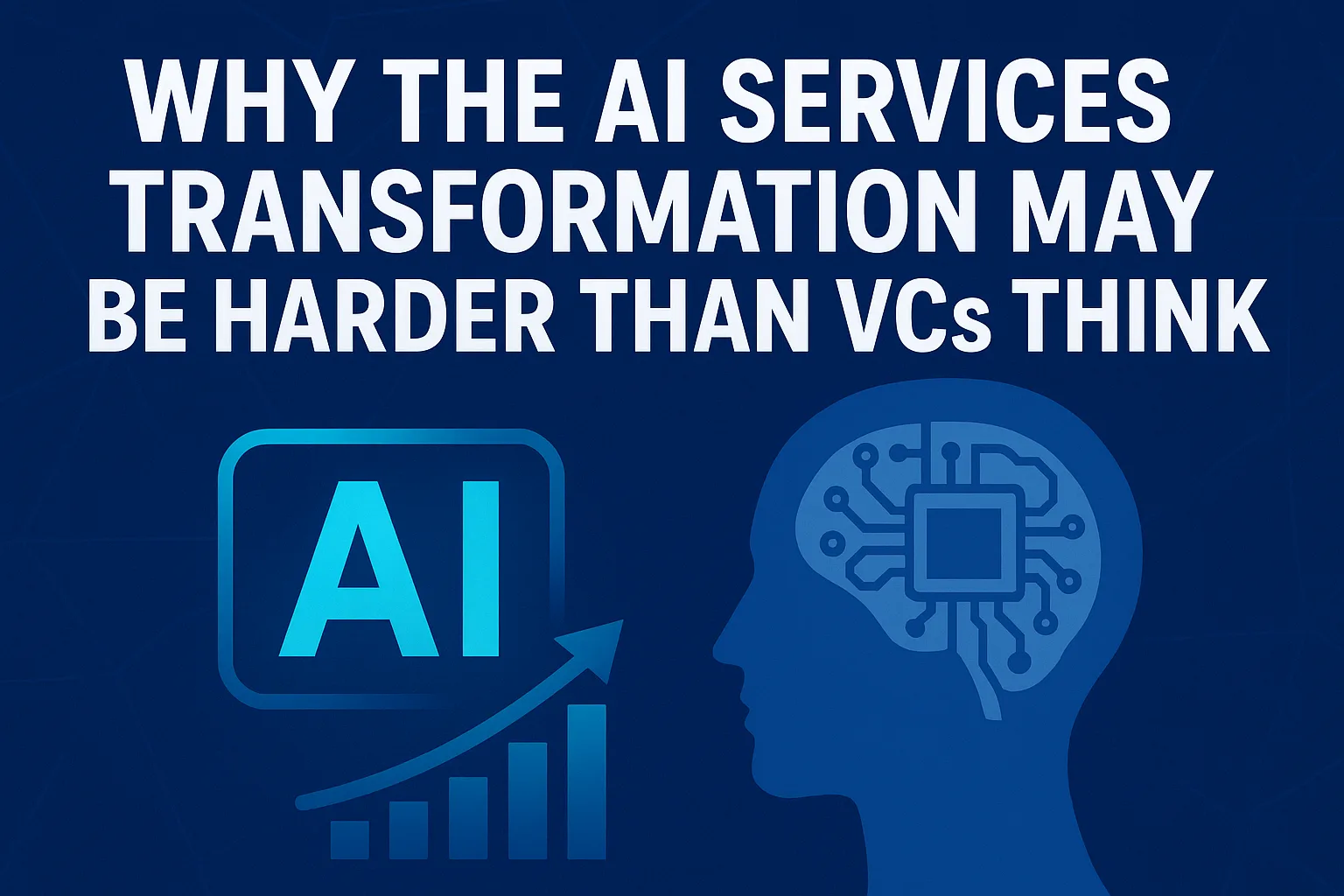Table of Contents
The Big Bet on AI Services Transformation
At Squaredtech, we have been closely following the rapid shift in investment strategies across venture capital. One of the most aggressive moves currently reshaping the market is the belief that AI services transformation can deliver software-like profit margins in industries that have historically been labor-intensive.
Venture capitalists are now pouring billions into strategies that involve acquiring mature professional services firms, layering in artificial intelligence to automate repetitive tasks, and then using improved margins to roll up more companies. The appeal is obvious. If software can scale with little additional cost, why not reimagine services through the same lens?
General Catalyst (GC) is leading this wave. The firm has allocated $1.5 billion to what it calls a “creation” strategy. The approach centers on incubating AI-native companies inside specific industries, then acquiring established firms in those same sectors. This allows GC to both own the technology and capture existing customers. Their targets span a wide range of services, from IT management to legal support, and they plan to expand into as many as 20 verticals.
As Marc Bhargava of GC explained, global services generate around $16 trillion in annual revenue, compared to software’s $1 trillion. The math is seductive. Automating even 30 to 50 percent of service-based work with AI could, in theory, unlock massive margin expansion. Call centers, for example, could automate up to 70 percent of routine tasks, dramatically reshaping the economics of customer support.
We acknowledges that the pitch sounds irresistible, but we believe this vision of AI services transformation is more difficult to achieve than venture capitalists suggest.
Read More About Our Article of OpenAI’s Teen-Friendly ChatGPT: Balancing Safety, Privacy, and Freedom for Young Users Published on September 18, 2025 SquaredTech
Case Studies That Fuel Investor Excitement
The excitement is not without evidence. Several case studies show how AI infusion is already reshaping services.
GC-backed Titan MSP illustrates the model well. Titan received $74 million in funding to develop AI tools for managed service providers. With those tools, Titan acquired RFA, a respected IT services firm, and quickly demonstrated the ability to automate 38 percent of standard tasks. The company now plans to reinvest its stronger margins into further acquisitions, scaling through a classic roll-up strategy.
Another example is Eudia, an AI-powered legal services company incubated by GC. Instead of traditional hourly billing, Eudia offers fixed-fee packages to major clients like Chevron, Southwest Airlines, and Stripe. By automating repetitive legal processes, they can deliver predictable pricing and higher efficiency. Eudia recently expanded by acquiring Johnson Hanna, an alternative legal service provider.
These examples strengthen the narrative that AI can double EBITDA margins for service businesses, which is the exact outcome VCs are chasing. Squaredtech recognizes that these models look compelling in early stages. However, we also see critical challenges that make the broader vision of AI services transformation far more complex.
Why AI Services Transformation May Be Harder Than VCs Think
For all the enthusiasm, warning signs are emerging. Squaredtech has reviewed research from Stanford Social Media Lab and BetterUp Labs, which surveyed more than 1,100 full-time employees across multiple industries. Their findings are telling. Forty percent of employees reported being burdened with what researchers call “workslop” — AI-generated output that looks polished but lacks true substance.
Instead of saving time, this content creates additional work. Employees spend nearly two hours per incident fixing, clarifying, or rejecting AI-generated material. The cost is measurable. Researchers estimate that workslop creates an invisible tax of $186 per employee per month. For a company with 10,000 employees, that equates to more than $9 million in lost productivity per year.
This insight matters because the entire investment thesis depends on margin expansion. If AI increases the burden on employees rather than reducing it, the economics break down. Companies may need to keep more staff on board to correct errors, limiting efficiency gains. Alternatively, if firms cut staff to chase higher margins, they may lack the human oversight required to correct flawed AI output, leading to operational risks.
From our perspective, this is the central contradiction of the current investment wave. AI services transformation is attractive on paper, but real-world implementation introduces hidden costs that may offset projected gains.
Read More About Our Article of WhatsApp’s New AI Summarizer Could Be Reading More Than Just Your Messages Published on July 21, 2025 SquaredTech
The Technical Puzzle of AI Services Transformation
Bhargava of GC acknowledges that transforming services with AI is not easy. He argues that the failures seen in corporate AI rollouts prove that the challenge is real — and therefore, an opportunity for specialists. According to him, the key lies in having applied AI engineers who understand the nuances of different models, their limitations, and how to wrap them effectively in software.
At Squaredtech, we agree that technical sophistication is crucial. AI is not a monolithic technology. Large language models excel in text generation but may hallucinate facts. Machine vision systems are powerful but require extensive labeled data. The right combination of tools varies by industry and task. That complexity means scaling AI solutions across multiple service sectors will require more than generic automation. It will require deep integration, domain expertise, and constant iteration.
This technical barrier is why many firms struggle to achieve promised efficiency gains. Unlike traditional software, AI is probabilistic. It does not always produce consistent outputs, and errors can compound quickly in high-stakes environments like legal review or IT security. Squaredtech believes these issues will slow down adoption and temper the optimism around AI services transformation.
Profitability vs. Reality in AI Services
One reason investors remain bullish is that this model produces profitability much earlier than typical VC strategies. By acquiring firms with existing cash flow, venture capitalists avoid the losses associated with funding high-growth startups. For limited partners, this shift toward immediate profitability is attractive.
But Squaredtech urges caution. While early margins may improve, the long-term sustainability of those margins depends on maintaining efficiency gains without creating hidden costs. The more “workslop” that flows through organizations, the more expensive it becomes to manage quality control. That reality could shrink the margin gap between AI-powered services and traditional operations.
There is also the issue of scaling. A roll-up strategy assumes that each new acquisition can achieve similar efficiency gains. If early wins are industry-specific or dependent on unique conditions, scaling to 20 sectors may not replicate the same results. Squaredtech highlights this as a major risk that is often underestimated in investor presentations.
What Squaredtech Concludes
The vision of AI services transformation is ambitious, and the financial upside is real. Automating a fraction of a $16 trillion services market would indeed generate enormous value. But the risks are equally significant. From hidden productivity losses caused by AI-generated errors to the technical complexity of scaling across industries, the path forward is not as straightforward as many venture capitalists suggest.
We believes the winners in this space will not be those who simply acquire and automate. Success will come to firms that balance AI automation with human oversight, invest in industry-specific expertise, and measure not just top-line efficiency but also the hidden costs of implementation.
In short, the AI services transformation may deliver breakthroughs, but it will be harder, slower, and more resource-intensive than today’s investment pitch decks imply.
Stay Updated: Money Talks – Artificial Intelligence


